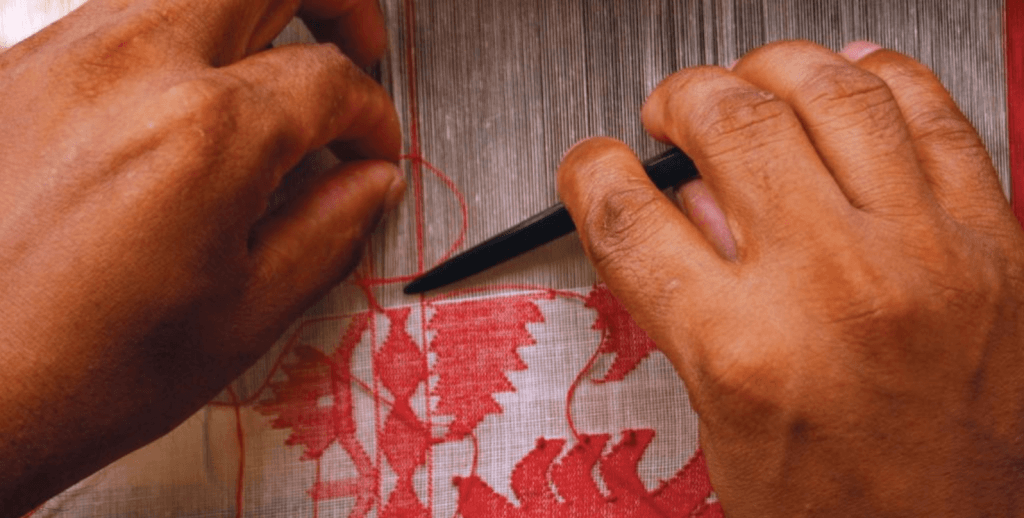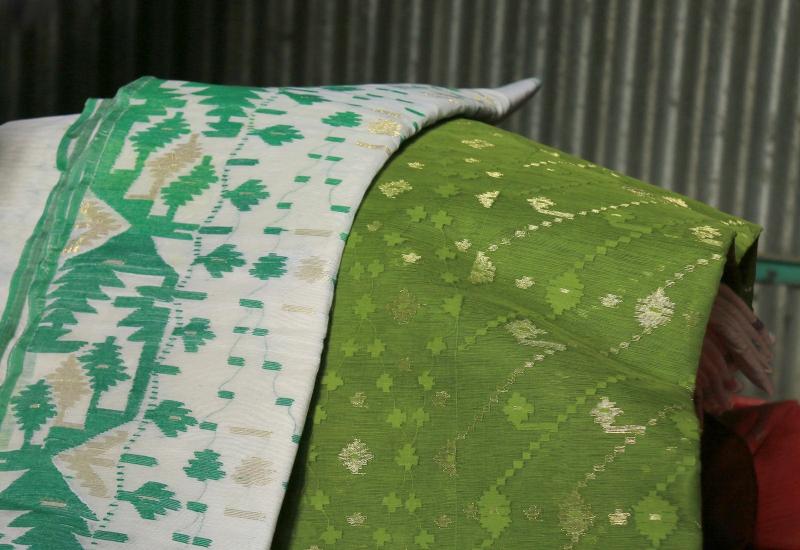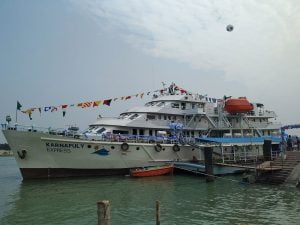The successor of muslin textiles knocked down the name Jamdani first. The Saree lovers call it admiring Madhabi, Malancha, Mala or Jui Phool, Terehya, HazaraButi, Chida. In the first place, the woven fabric in cotton, which figured or flowered, blows the mind of the Saree lovers. The history of Jamdani bears the geometric or floral designs in the Dhaka region over the centuries. It must be remembered that the dresses, including Khrta and Sherwani which were made with Jamdani Fabric, were very popular in the 17th century as well as Mughal region. To point out, UNESCO declared the traditional art of Jamdani as the Intangible Cultural Heritage of Humanity and it received geographical indication (GI) status.

The villagers of Noapara, Ruposhi, Mikuli, Khadun, Pabanakul, Murgakul, and Darab on the east bank of Shitalakshya are working hard day and night to weave Jamdani. Maybe the environment and the weavers of South Rupshi of Narayanganj district are suitable for knitting it. The elegance of Jamdani lies in its design. You can’t imagine the design is full of fine and tangled craftsmanship. It is important to realize the demand for Jamdani depends on its flashy crafts and designs. Notably, the special combination of cotton and gold thread is defined to weave Jamdani.
The main point of Jamdani is Rupganj and Noapara, which is on the side of the Shitalakshya River. It is thought that one day, it will also be a part of Sonargaon. Hopefully, in the last decade, the Faridpur and Bhairab districts will also be sewing the Jamdani. If we see the stats of Bengal Govt. from 1907 to 1908, we get that then the Dhamrai and some of the parts of Dhaka city weave the Jamdani. We get a lot of stories of Nawab for loving Jamdani as well.
- Know More: People Of Bangladesh
The (Design) History of Jamdani:
Researchers express different opinions on the varieties of creative design of Jamdani cloth. According to some of them, the design of Jamdani has the effect of carpets and folk designs of Iran, Iraq, and Turkish. As a matter of argument, it was explained that Mughal emperors were fond of Persian cultural ways. They brought Many Iranian artisans and craftsmen several times to the Indian subcontinent. Not only that, in different aspects, they sponsored Persian culture only for the love of their hard work and creativity. In this case, the Iranian, Iraqi, or Turkish designs of Jamdani may have been introduced.
- Top 15 Waterfalls in Bangladesh You Shouldn’t Miss
On the other hand, according to some of the researchers, the design of Jamdani is purely the creativity and creation of Bengal weavers. As a reason, they mentioned that Jamdani’s design prioritizes Bangladesh’s environment, nature, living organisms, and tree design. In their commentary, a Jamdani-weaver emerges in his design, which he has watched in the surroundings. Then Again, in particular, many of them are similar to the design of the Chakma people in Jamdani. Following the different doctrines, Mohammad Saidur, the author of the book “Jamdani,” expresses that Jamdani’s design did not originate from the influence of the country itself. Rather, it came in the time of various tribal influences, Hindu-Buddhist influence, Muslim influence, British influence, Pakistanis and now Bangladeshi influence. So, it is a mixed form of various effects, and according to tradition, these effects are combined together in the traditional jamdani design. It should be noted that, during the Sultanate and Mughal periods, this industry received special patronage from the Muslim rulers. For this reason, it is not unusual to stay the effect of Persian. Surely, it is assumed that with the passing of time, the design has been localized. In the twenty-first century, Jamdani’s design has emerged, flowing through a long-term transformation process.
The Evolution of Jamdani Design:
When it comes to the design of the Jamdani, we can imagine the saree with colorful flowers and geometric mold. Surprisingly, the colorful Jamdani design is only about a hundred years old. Though researchers always tell Jamdani is the infatuation’s form of muslins. Therefore, it is possible to think that Jamdani’s original design was made with white yarn above white cotton. However, it can be said that a very small amount of color yarn is also used.
- Read More About The History Of Bangladesh
If we search for any eyewitnesses about the evolution of Jamdani’s design, we find Hakim Habibur Rahman (1881-1947). He has said, that from our childhood, the best form of Jamdani was the white-colored Jamdani named Ashrafi Boti, Matsubuti, Jalidar, and Laharia and this is the ancient trend. However, Hakim Habibur Rahman also said that the introduction of black and red booty on the sari began in his childhood. In 1945, he said, “50 years ago, Jamdani was made only by the white, but the work of red-black in saree’s lace was fine from the fine, the texture was white, and that was the original style. George W. and Percy Brown gave similar information about the evolution of Jamdani’s design.

Then the design of Jamdani began to change with the passing of time. Hakim Habibur Rahman said this change was associated with the Nawab Sir Salimullah (1871-1915). ‘… First of all, he inspired me to use different colors and flowers with different designs with different types of colors. That is to say, he started using colorful Jamdani for the first time. He worked to design Large flora in the flower and at the end of his life, he spent a large part of his time developing such a design. Surely, this Jamdani was very expensive. The wealthy and noble people of Bengal started using it and the use of white Jamdani was almost wiped out. That is to say, Nawab Sir Salimullah patronized and started to make colorful Jamdani in the last decade of the nineteenth century or at the beginning of the twentieth century. At the same time, it started to become popular. It is interesting to know that when Nawab was at the end of his life, he was a full designer of Jamdani. According to Hakim Habibur Rahman, the time of Nawab Sir Salimullah is the golden age of the colorful design of the Jamdani cloth. Then all the designs including the flowers, birds, and spinach in Jamdani, were colorful.
- Check the Geography Of Bangladesh
Originally, The design of Jamdani was divided into two parts – Border (Paar) and texture (Jomin). There are different names in the border and texture design. In general, the Jamdani dress, especially the saree, is named after the name of the border, such as the KalkaPar saree, MulanchaPar saree, etc. To design a Jamdani sari, the design of the shores or border works as the main foundation. The design is usually made of different types of spinach, flowers, and animals. The designer adorns the border with a motif. The complete designs of the border depend on this motif. At the side of this motif, there are several similar small designs/graphs. With the combination of these designs, the cloth gets fulfillment.

After the design of the border, the most diverse design of Jamdani lies on texture or ground. There are three basic types of design for designing texture. These are Jaal, Butti/Chida, and Terchi. Apart from this, some waves and shapes were made in the ground. Whenever any design is wavy, like a wave of water, it is known as a ‘wave.’ Generally, the design of the border is knitted as the design of the silk (Aachol). The beauty of the Jamdani prevails with the three main designs of the border (Paar), texture (Jomin), and silk (Aachol).
When the pride or nobility of Jamdani describes that, it is in his design. It becomes most expensive when the design is dense, heavy and unique. This simple equation did not break even today. No matter how complex the design is, the Jamdani weavers adapted the outside lines of the design to their handloom straight line and parallel skill.

Surprisingly, what Jamdani artisans see around them can be illustrated with the design in Jamdani—for example, Ashfulpar, Jhumkapar, Armorer Mouarpar, Nishanpar, Puilatapar, Supeeri Tangkipar, etc. ‘Ashful’ is basically the shape of a flower-shaped head of two swans (In Rupganj, Ash has been pronounced as duck locally). JumkaPar is a portrait of a particular earring design. Armorer Mouarpar is the mango crown. Nishan is a three-pronged flag. Puilatapar is the tip of the herb. Supeeri Tangkipar is a beta cheeker. In this way, various things around weavers are seen in the Jamdani design. These designs are reddish, blue, black, violet, green and white, and pleasant colors have made Jamdani imaginative and royal.
The special quality of the Jamdani weavers is the ability to adapt themselves to complex and unique designs. It is necessary to say the weavers of recent times have the weakness of this special quality. The main reason for this drawback is that huge corporate capital has now entered into the development of Jamdani’s design. The city-based designers are designing Jamdani for the orders of various big organizations! Those designs are going away in the Mohajon’s (The moneylender) ‘Bangla’ (Local, the factory is mentioned as Bangla in Bengali). The craftsmen are just shedding those designs in the weaving machine. The craftsmen do not feel the need to innovate new designs like before. The ‘urban design’ does not come to those who are not associated with the ‘Bangla’ of Mohajon. But they are also doing ‘copy-paste’. Otherwise, they are running old designs by changing a little bit. Most of them are not interested in creating any new designs. But yes, some of the big corporate houses have a great collection of old designs. From those old designs, the designers are now making new designs for Jamdani.

On the positive side, it needs to be said that new designs have not been invented, but the weavers or craftsmen have not yet stepped away from the creativity of knitting. For this reason, the 100% Hand-woven Jamdani design is still royal and elite.
- Know More About The Weather of Bangladesh.
Information about Jamdani
- Once, the women were not allowed to weave Jamdani cloth. It was thought that if women learned to weave jamdani, they would start to weave jamdani after going to their in-law’s house after marriage. The business will be unbearable.
- The Jamdani was made with the hand-made cotton. Locally, Jamdani is still hand-crafted in the handlooms. The lumber used for making jamdani cloth is locally named as ‘paddy’.

- For designing Jamdani, the weavers use Kandul, which is designed with buffalo horn. Although the plastic Kandul is now available in the market.
- Jamdani Saree is named after the design name of the Border (Paar) of the saree.
- A special type of cotton is cultivated for weaving Jamdani but is not available now. It is thought that in the nineteenth century, the local species of cotton became extinct.
- Jamdani cloths are made with two weavers in a loom. The person who is sitting on the right side is the master craftsman. The person who sits on the left side is the helper.
- From early childhood, Jamdani weavers are taught to make cloth. It is believed that in childhood, the hands stay very soft so they can create a good design.

- In the vast area between the rivers of Shitalakshya, Meghna, and Brahmaputra, cotton was cultivated for Jamdani clothes. Muslin cloth was also made with this cotton.
- Two types of Jamdani are made, named Hafsilk and Phulkatan. Silk yarn in the texture and Cotton yarn in the border is used for Hafsilk. And silk yarn in the texture and border is used for Phulkatan. There are two other types of Jamdani – Phulcotton and nylon.
- Now, Jamdani is made in different villages of Rupganj and Sonargaon Upazila of Narayanganj district. Apart from this, Jamdani sarees were made in some villages of Bhairab and Faridpur.
- The ‘Tangail Jamdani’ which is sold in the market, is not the real Jamdani. Only Jamdani designs are drawn in these sarees. Although the Tangail Saree is made with Chittaranjan loom.
Check Also: Art And Culture Of Bangladesh
References 1. Hakim Habibur Rahman, 'Dhaka: Fifty Years Ago', Anu. Dr. Mohammad Rezaul Karim, Papyrus, Dhaka, 2005. 2. Lala Rukh Selim (Sup.), 'Charu and Curricula', Asiatic Society of Bangladesh, Dhaka, 2007. 3. Mohammad Saidur, 'Jamdani', Bangla Academy, Dhaka, 1993. 4. Tofail Ahmad, 'Our Ancient Art', Bangla Academy, Dhaka, 1992. 5. Anarjo Taposh, 26 March 2019, (Dhakai Jamdanir Rongin Bhuvon) Prothom-alo.






